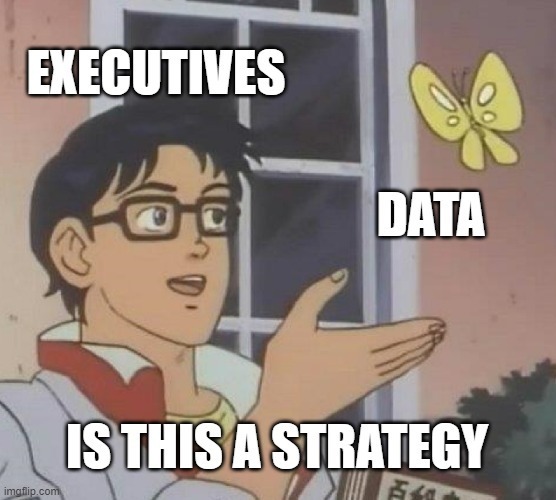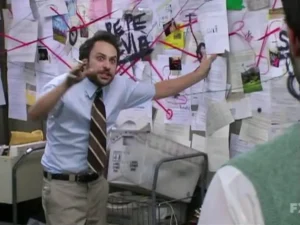By Sam Manz, Director of Brand Experience
This article delves into the true meaning of “strategy,” defining it as a plan to achieve long-term goals in an uncertain environment, particularly within marketing. It emphasizes that effective strategy begins with deep, targeted data collection and insight generation, moving beyond surface-level information to gain profound knowledge about a market or problem. The piece highlights that strategy is an art form requiring informed opinion, collaboration, and a willingness to be creative and disruptive. Ultimately, a successful strategy must not only meet objectives but also position a brand distinctly to become top-of-mind and challenge existing market perceptions.

What IS Strategy?
Let this sink in: 46% of agency employees think strategy is a scam. I mean, these are my people. So, is it bogus or does it underpin any potential success we gain for ourselves and our clients?
What exactly is Strategy? To paraphrase Hugh Grant in 2003’s Love Actually, “If you look for it, I’ve got a sneaky feeling you’ll find that love [strategy] actually is all around”
Strategy is me writing this blog to tell you what strategy is so I can position myself as a witty intellectual worth knowing more about… strategy. Strategy is you reading this blog so you can learn more about strategy and how you, too, can be a witty intellectual. Strategy is both of us knowing that neither one of those things is strategy — they are simply strategic. Got ya. 😉
Simply defined, strategy is “a general plan to achieve long-term goals in an uncertain environment” (at least according to Google AI). But a good novel once told me that the best words are monogamous, and strategy as a word is certainly not that. Some other definitions of strategy might be:
- Determining how we will win in the period ahead
- A general plan or set of plans intended to achieve something, especially over a long period.
- The science and art of employing the political, economic, psychological, and military forces of a nation or group of nations to afford maximum support for adopted policies in peace or war
- An adaptation (or complex of adaptations, as of behavior, metabolism, or structure) that serves or appears to serve an important function in achieving evolutionary success
The list goes on. Don’t even get me started on the rabbit hole of classical strategy vs. a marketing strategy, differentiation strategy, or animal survival strategy. For all their differences, strategy types are really situational and tend to intersect at points. Ants, for instance, use tactics very similar to human war strategies to forage for food and to survive (e.g., laying down chemical trails to coordinate group movements and stay connected to headquarters, the nest). Is this what my boss means when he says he wants me to develop a strategy? Maybe I should request a title change from strategist to Ant-Man and get a cool, shiny costume.
But I digress. Why am I writing this, and – just as important — why are you reading it? To get a sense of where to start when creating a strategy, whatever the use case may be, even if you want to use it to forage for leaves 4x your size.
Let’s break it down.
Start with Data & Insights
These two work hand-in-hand. You forage for data (see what I did there?), searching far and wide across databases, scholarly journals, AI tools, quarterly reports, and more to collect facts and statistics that allow you to garner insights from said data, and…blah blah blah.
Here’s the real point: Data is a valuable tool within, but you need to wield it properly. If you’re not Doug Marcaida brandishing data and telling me “it will keal,” then I don’t want to hear it. (Google him. You won’t be sorry.)
That said, not all data is good data, and frankly, not all insights are insights. For example, let’s say our goal overall is to generate frozen yogurt sales and we are trying to determine the best strategy to do so. We’ll want to do some market research to determine:
- Competitor landscape. What does the frozen yogurt landscape look like? How many companies are there? What are their differentiators? Where are they located? What is their product lineup?
- Frozen dessert market. What is the makeup of the frozen dessert market? Who is the primary audience? Who are the other key frozen players (ice cream, popsicles, etc.)?
- Company sentiment. How do consumers feel about the company we’re driving sales for? What are they saying specifically (strengths, weaknesses)? What problem does the company solve and are they doing a good job of that?
There is more to dig into and those are good places to start, but let the data drive your answers. As you find facts — such as ice cream held a major frozen market share of 58.4% in 20221 — you’ll want to drill into those more. What insight can we discern from this data? It might be that while more than half of the market is infatuated with ice cream, a large chunk of frozen dessert consumers looking for alternatives exists. So why is that? Dig deeper. And when you’re done, dig even deeper.
Deeper, not wider, is the name of this game. We are a Kentucky Derby horse with blinders on, focused only on the finish line, not the other colts. We don’t care about brownies, cake pops, or anything other than frozen dessert data and how it impacts our frozen yogurt client’s sales. So go deep and narrow into that market to draw truly targeted insights.
Information Becomes Knowledge
We have data, we have insights, but what do we do with them? Those things are not a strategy, despite what you might hear. They are stepping stones; what we leverage on the journey to knowledge. The questions are, what do we know for sure and what don’t we know?
We might know that there is a possible correlation between ice cream and drowning.2 We might also know that, as of 2023, chocolate is the most popular frozen yogurt flavor in the world.3 What we do not know for sure is that either one of these tidbits mean anything in creating a strategy to increase frozen yogurt sales for our client.
This is for you, the strategist, to figure out. Sift through information, discarding what is relevant and what is not-. Strategy is an art form — it’s not always black and white — so don’t be afraid to use your informed opinion and make inferences. Utilize your team as a sounding board. Ask them if they like chocolate frozen yogurt and what would make them visit the client’s frozen yogurt shop. I might say to you that I’m more of a mango froyo gal myself with popping boba and fresh fruit (but that I will pretend to want brownie toppings so I can sneak a brownie bite in for free as I head to the check-out counter). You might be plain vanilla.
But wait. Maybe the popular flavors are less important to the strategy than we thought. Maybe what we know about flavor segmentation and ice cream mishaps actually indicates that we should take a step back and understand the user experience a bit more.
So F**king What?

Paralysis by analysis. The strategy sleep demons come forth at this point and you end up at a whiteboard looking like Charlie from It’s Always Sunny with crazed eyes and a plethora of information, data, and perceived knowledge that is causing you to question if people even like frozen desserts at all or if they simply are too warm in the summer and desperate for something to cool them down. Perhaps an ice cube would satisfy them, and our strategy should incorporate Kristoff from Frozen cooling you down shirtless with a large ice block he harvested. Zero calories, ice cold, and premiere customer service? Sold. But, alas, sell frozen yogurt we must, and, therefore, we need to make sense of the information and formulate our strategy at last.
Knowing what we know (because we’ve done the research), how can we disrupt the frozen dessert market and give ice cream a swift 300-style kick out of its top spot to make way for frozen yogurt?
The ~ Strategy ~
Strategy and creativity work side-by-side. To create a strategy is to create art, and art is subjective. You have to be unafraid to step out of your comfort zone, outside of the data and outside of society’s perception of a product or service. Use your data, insights, and knowledge to determine the problem you’re trying to solve, what information you know about this problem, the advantage or differentiator our frozen yogurt client has to leverage, and how all of that relates to our objective.
You may think that a lack of frozen yogurt sales is the problem, but you’re wrong! HA HA! Our key goal here is to increase sales, but the problem we’re trying to solve is that frozen yogurt is not a frozen dessert consumers’ first choice at least half of the time they are seeking icy treats. We know that ice cream is that top choice, and so our strategy must seek to position frozen yogurt as a better choice than ice cream when they are making that decision (and at all times tbh).
One such strategy might be that “frozen yogurt saves lives.” Crazy statement (definitely not external facing), but the facts back it up: there is no correlation between frozen yogurt and drowning to start. This strategy inspires creativity — think of the AI advertisements now — a froyo cone dressed as a lifeguard, or a toppings bar acting as a life preserver.
Here’s the point: At the end of the day, your strategy needs to not only meet the objective but also disrupt the day-to-day and bring the brand to the top of mind.